Thermal Management Techniques in Metal Hydrides for Hydrogen Storage Applications: A Review
Abstract
1. Introduction
Challenges in the Widespread Use of Metal Hydrides
2. Methods
3. Metal Hydrides
4. Reactor House Shape Optimization
4.1. Tubular Reactors
4.2. Disc Reactors
4.3. Chamber Reactors
5. Heat Transfer Techniques
5.1. Phase Change Fluid Flow Designs
5.2. Adding Cooling Tubes/Water Jackets
5.3. Improvement of Effective Thermal Conductivity of Metal Hydride Bed (High Thermal Conductivity Materials)
5.3.1. Compaction
5.3.2. Addition of High Thermal Conductivity Materials
5.3.3. Innovative High Thermal Conductive Structures
5.3.4. Other Non-Conventional Methods
5.4. Performance Comparison and Selection
6. Conclusions
Author Contributions
Funding
Data Availability Statement
Conflicts of Interest
References
- Schlapbach, L.; Züttel, A. Hydrogen-Storage Materials for Mobile Applications. Nature 2001, 414, 353–358. [Google Scholar] [CrossRef] [PubMed]
- Huot, J. Metal Hydrides. In Handbook of Hydrogen Storage; Hirscher, M., Ed.; Wiley-VCH Verlag GmbH & Co. KGaA: Weinheim, Germany, 2010; pp. 81–116. ISBN 9783527322732. [Google Scholar]
- Sun, D.-W.; Deng, S.-J. A Theoretical Model Predicting the Effective Thermal Conductivity in Powdered Metal Hydride Beds. Int. J. Hydrogen Energy 1990, 15, 331–336. [Google Scholar] [CrossRef]
- Sandrock, G.; Bowman, R.C. Gas-Based Hydride Applications: Recent Progress and Future Needs. J. Alloys Compd. 2003, 356–357, 794–799. [Google Scholar] [CrossRef]
- Block, F.R.; Dey, A.; Kappes, H.; Reith, K. Hydrogen Purification with Metal Hydrides in a New Kind of Reactor. J. Less Common Met. 1987, 131, 329–335. [Google Scholar] [CrossRef]
- Krane, P.; Nash, A.L.; Ziviani, D.; Braun, J.E.; Marconnet, A.M.; Jain, N. Dynamic Modeling and Control of a Two-Reactor Metal Hydride Energy Storage System. Appl. Energy 2022, 325, 119836. [Google Scholar] [CrossRef]
- Zhang, X.; Liu, L.; Wang, J.; Ju, X.; Si, R.; Feng, J.; Guo, J.; Chen, P. The Role of Lanthanum Hydride Species in La2O3 Supported Ru Cluster Catalyst for Ammonia Synthesis. J. Catal. 2023, 417, 382–395. [Google Scholar] [CrossRef]
- Lv, Y.; Zhang, X.; Chen, W.; Ju, S.; Liu, Z.; Xia, G.; Ichikawa, T.; Zhang, T.; Yu, X. Ion Diffusion, and Hysteresis of Magnesium Hydride Conversion Electrode Materials. J. Mater. Sci. Technol. 2023, 155, 47–53. [Google Scholar] [CrossRef]
- Zhou, P.; Cao, Z.; Xiao, X.; Zhan, L.; He, J.; Zhao, Y.; Wang, L.; Yan, M.; Li, Z.; Chen, L. Development of RE-Based and Ti-Based Multicomponent Metal Hydrides with Comprehensive Properties Comparison for Fuel Cell Hydrogen Feeding System. Mater. Today Energy 2023, 33, 101258. [Google Scholar] [CrossRef]
- Tiwari, S.; Sharma, P. Integration of Metal Hydride Reactor with Thermocline Based Heat Storage System. J. Energy Storage 2023, 59, 106506. [Google Scholar] [CrossRef]
- Kumar, A.; Muthukumar, P. Experimental Investigation on the Poisoning Characteristics of Methane as Impurity in La0.9Ce0.1Ni5 Based Hydrogen Storage and Purification System. Energy 2022, 259, 124888. [Google Scholar] [CrossRef]
- Krishnamoorthy, U.; Gandhi Ayyavu, P.; Panchal, H.; Shanmugam, D.; Balasubramani, S.; Al-rubaie, A.J.; Al-khaykan, A.; Oza, A.D.; Hembrom, S.; Patel, T.; et al. Efficient Battery Models for Performance Studies-Lithium Ion and Nickel Metal Hydride Battery. Batteries 2023, 9, 52. [Google Scholar] [CrossRef]
- Zhang, M.; Liang, X.; Wang, Y.; Yang, H.; Liang, G. Insights into the Capture of CO2 by Nickel Hydride Complexes. Catalysts 2022, 12, 790. [Google Scholar] [CrossRef]
- Brestovič, T.; Jasminská, N.; Lázár, M. Measurements of Operating Parameters of a Metal Hydride Compressor with a Heat Pump. Appl. Sci. 2022, 12, 3302. [Google Scholar] [CrossRef]
- Massaro, M.C.; Biga, R.; Kolisnichenko, A.; Marocco, P.; Monteverde, A.H.A.; Santarelli, M. Potential and Technical Challenges of On-Board Hydrogen Storage Technologies Coupled with Fuel Cell Systems for Aircraft Electrification. J. Power Sources 2023, 555, 232397. [Google Scholar] [CrossRef]
- Nguyen, H.Q.; Shabani, B. Thermal Management of Metal Hydride Hydrogen Storage Using Phase Change Materials for Standalone Solar Hydrogen Systems: An Energy/Exergy Investigation. Int. J. Hydrogen Energy 2022, 47, 1735–1751. [Google Scholar] [CrossRef]
- Eadi, S.B.; Oh, J.S.; Kim, C.; Sim, G.; Kim, K.; Kim, H.Y.; Kim, J.J.; Do, H.R.; Chu, S.; Jung, S.H.; et al. Improved Hydrogen Gas Sensing Performance of Pd–Ni Alloy Thin Films. Int. J. Hydrogen Energy 2023, 48, 12534–12539. [Google Scholar] [CrossRef]
- Kumar, S.; Sharma, R.; Srinivasa Murthy, S.; Dutta, P.; He, W.; Wang, J. Thermal Analysis and Optimization of Stand-Alone Microgrids with Metal Hydride Based Hydrogen Storage. Sustain. Energy Technol. Assess. 2022, 52, 102043. [Google Scholar] [CrossRef]
- Tian, H.; Wang, Z.; Guo, Z.; Yu, R.; Cai, G.; Zhang, Y. Effect of Metal and Metalloid Solid-Fuel Additives on Performance and Nozzle Ablation in a Hydroxy-Terminated Polybutadiene Based Hybrid Rocket Motor. Aerosp. Sci. Technol. 2022, 123, 107493. [Google Scholar] [CrossRef]
- Lee, C.-Y.; Shen, C.-C.; Chiu, C.-W.; Hsieh, H.-T. Real-Time Micro-Monitoring of Surface Temperature and Strain of Magnesium Hydrogen Tank through Self-Made Two-In-One Flexible High-Temperature Micro-Sensor. Micromachines 2022, 13, 1370. [Google Scholar] [CrossRef] [PubMed]
- Sezgin, B.; Devrim, Y.; Ozturk, T.; Eroglu, I. Hydrogen Energy Systems for Underwater Applications. Int. J. Hydrogen Energy 2022, 47, 19780–19796. [Google Scholar] [CrossRef]
- Ren, K.; Miao, J.; Shen, W.; Su, H.; Pan, Y.; Zhao, J.; Pan, X.; Li, Y.; Fu, Y.; Zhang, L.; et al. High Temperature Electrochemical Discharge Performance of LaFeO3 Coated with C/Ni as Anode Material for NiMH Batteries. Prog. Nat. Sci. Mater. Int. 2022, 32, 684–692. [Google Scholar] [CrossRef]
- Dashbabu, D.; Kumar, E.A.; Jain, I.P. Thermodynamic Analysis of a Metal Hydride Hydrogen Compressor with Aluminium Substituted LaNi5 Hydrides. Int. J. Hydrogen Energy 2022. [Google Scholar] [CrossRef]
- Jana, S.; Raju, N.N.; Muthukumar, P. Performance Tests on Embedded Cooling Tube Type Metal Hydride Reactor for Heating and Cooling Applications. Therm. Sci. Eng. Prog. 2022, 33, 101349. [Google Scholar] [CrossRef]
- Raj Singh, U.; Sai Kaushik, A.; Sekhar Bhogilla, S. A Novel Renewable Energy Storage System Based on Reversible SOFC, Hydrogen Storage, Rankine Cycle and Absorption Refrigeration System. Sustain. Energy Technol. Assess. 2022, 51, 101978. [Google Scholar] [CrossRef]
- Chang, H.; Tao, Y.B.; Ye, H. Numerical Study on Hydrogen and Thermal Storage Performance of a Sandwich Reaction Bed Filled with Metal Hydride and Thermochemical Material. Int. J. Hydrogen Energy 2023. [Google Scholar] [CrossRef]
- Lototskyy, M.; Satya Sekhar, B.; Muthukumar, P.; Linkov, V.; Pollet, B.G. Niche Applications of Metal Hydrides and Related Thermal Management Issues. J. Alloys Compd. 2015, 645, S117–S122. [Google Scholar] [CrossRef]
- Sandrock, G. Hydride Storage. In Handbook of Fuel Cells; John Wiley & Sons, Ltd.: Chichester, UK, 2010. [Google Scholar]
- Sheft, I.; Gruen, D.M.; Lamich, G.J. Current Status and Performance of the Argonne Hycsos Chemical Heat Pump System. J. Less Common Met. 1980, 74, 401–409. [Google Scholar] [CrossRef]
- Bjurstrom, H.; Komazaki, Y.; Suda, S. The Dynamics of Hydrogen Transfer in a Metal Hydride Heat Pump. J. Less Common Met. 1987, 131, 225–234. [Google Scholar] [CrossRef]
- Lee, S.-G.; Lee, H.-H.; Lee, K.-Y.; Lee, J.-Y. Dynamic Reaction Characteristics of the Tubular Hydride Bed with Large Mass. J. Alloys Compd. 1996, 235, 84–92. [Google Scholar] [CrossRef]
- Park, J.-G.; Han, S.-C.; Jang, H.-Y.; Lee, S.-M.; Lee, P.S.; Lee, J.-Y. The Development of Compressor-Driven Metal Hydride Heat Pump (CDMHHP) System as an Air Conditioner. Int. J. Hydrogen Energy 2002, 27, 941–944. [Google Scholar] [CrossRef]
- Klein, H.-P.; Groll, M. Development of a Two-Stage Metal Hydride System as Topping Cycle in Cascading Sorption Systems for Cold Generation. Appl. Therm. Eng. 2002, 22, 631–639. [Google Scholar] [CrossRef]
- Muthukumar, P.; Prakashmaiya, M.; Srinivasamurthy, S. Experiments on a Metal Hydride Based Hydrogen Compressor. Int. J. Hydrogen Energy 2005, 30, 879–892. [Google Scholar] [CrossRef]
- Veerraju, C.; Gopal, M.R. Heat and Mass Transfer Studies on Elliptical Metal Hydride Tubes and Tube Banks. Int. J. Hydrogen Energy 2009, 34, 4340–4350. [Google Scholar] [CrossRef]
- Gopal, M.R.; Murthy, S.S. Experiments on a Metal Hydride Cooling System Working with ZrMnFe/MmNi4.5Al0.5 Pair. Int. J. Refrig. 1999, 22, 137–149. [Google Scholar] [CrossRef]
- Ron, M. A Hydrogen Heat Pump as a Bus Air Conditioner. J. Less Common Met. 1984, 104, 259–278. [Google Scholar] [CrossRef]
- Park, J.-G.; Jang, K.-J.; Lee, P.S.; Lee, J.-Y. The Operating Characteristics of the Compressor-Driven Metal Hydride Heat Pump System. Int. J. Hydrogen Energy 2001, 26, 701–706. [Google Scholar] [CrossRef]
- Chernikov, A.; Izhvanov, L.; Solovey, A.; Frolov, V.; Shanin, Y. An Installation for Water Cooling Based on a Metal Hydride Heat Pump. J. Alloys Compd. 2002, 330–332, 907–910. [Google Scholar] [CrossRef]
- Werner, R.; Groll, M. Two-Stage Metal Hydride Heat Transformer Laboratory Model: Results of Reaction Bed Tests. J. Less Common Met. 1991, 172–174, 1122–1129. [Google Scholar] [CrossRef]
- Goodell, P.D. Thermal Conductivity of Hydriding Alloy Powders and Comparisons of Reactor Systems. J. Less Common Met. 1980, 74, 175–184. [Google Scholar] [CrossRef]
- Anevi, G.; Jansson, L.; Lewis, D. Dynamics of Hydride Heat Pumps. J. Less Common Met. 1984, 104, 341–348. [Google Scholar] [CrossRef]
- Wang, Y.; Yang, F.; Zhang, Z.; Feng, X.; Guo, Q. Design and Process Simulation of Metal Hydride Reactors. Hsi-An Chiao Tung Ta Hsueh/J. Xi’an Jiaotong Univ. 2006, 40, 831–835. [Google Scholar]
- Zhang, Z.; Wang, Y.; Feng, X.; Yang, F.; Guo, Q. An Annulus-Disc Type Chemical Heat Pump Reactor. 2007. Available online: https://patents.google.com/patent/CN1303379C/zh (accessed on 9 April 2023).
- Bogdanović, B.; Ritter, A.; Spliethoff, B.; Straβburger, K. A Process Steam Generator Based on the High Temperature Magnesium Hydride/Magnesium Heat Storage System. Int. J. Hydrogen Energy 1995, 20, 811–822. [Google Scholar] [CrossRef]
- Lévesque, S.; Ciureanu, M.; Roberge, R.; Motyka, T. Hydrogen Storage for Fuel Cell Systems with Stationary Applications— I. Transient Measurement Technique for Packed Bed Evaluation. Int. J. Hydrogen Energy 2000, 25, 1095–1105. [Google Scholar] [CrossRef]
- Wakao, S.; Sekine, M.; Endo, H.; Ito, T.; Kanazawa, H. A Heat Storage Reactor for Metal Hydrides. J. Less Common Met. 1983, 89, 341–350. [Google Scholar] [CrossRef]
- Dehouche, Z.; de Jong, W.; Willers, E.; Isselhorst, A.; Groll, M. Modelling and Simulation of Heating/Air-Conditioning Systems Using the Multi-Hydride-Thermal-Wave Concept. Appl. Therm. Eng. 1998, 18, 457–480. [Google Scholar] [CrossRef]
- Qin, F.; Chen, J.; Lu, M.; Chen, Z.; Zhou, Y.; Yang, K. Development of a Metal Hydride Refrigeration System as an Exhaust Gas-Driven Automobile Air Conditioner. Renew. Energy 2007, 32, 2034–2052. [Google Scholar] [CrossRef]
- Payá, J.; Linder, M.; Laurien, E.; Corberán, J.M. Dynamic Model and Experimental Results of a Thermally Driven Metal Hydride Cooling System. Int. J. Hydrogen Energy 2009, 34, 3173–3184. [Google Scholar] [CrossRef]
- Mellouli, S.; Askri, F.; Dhaou, H.; Jemni, A.; Ben Nasrallah, S. A Novel Design of a Heat Exchanger for a Metal-Hydrogen Reactor. Int. J. Hydrogen Energy 2007, 32, 3501–3507. [Google Scholar] [CrossRef]
- Yonezu, I.; Nasako, K.; Honda, N.; Sakai, T. Development of Thermal Energy Storage Technology Using Metal Hydrides. J. Less Common Met. 1983, 89, 351–358. [Google Scholar] [CrossRef]
- Mosher, D.A.; Arsenault, S.; Tang, X.; Anton, D.L. Design, Fabrication and Testing of NaAlH4 Based Hydrogen Storage Systems. J. Alloys Compd. 2007, 446–447, 707–712. [Google Scholar] [CrossRef]
- Verga, M.; Armanasco, F.; Guardamagna, C.; Valli, C.; Bianchin, A.; Agresti, F.; Lo Russo, S.; Maddalena, A.; Principi, G. Scaling up Effects of Mg Hydride in a Temperature and Pressure-Controlled Hydrogen Storage Device. Int. J. Hydrogen Energy 2009, 34, 4602–4610. [Google Scholar] [CrossRef]
- Dehouche, Z.; Peretti, H.; Yoo, Y.; Belkacemi, K.; Goyette, J. Catalyzed Light Hydride Nanomaterials Embedded in a Micro-Channels Hydrogen Storage Container. Recent Pat. Nanotechnol. 2009, 3, 116–134. [Google Scholar] [CrossRef] [PubMed]
- Meng, X.; Yang, F.; Wang, Y.; Deng, J.; Zhang, Z. Design and Process Simulation of a Micro-Channel Chemical Heat Pump Reactor. In Proceedings of the Chinese Chemical Engineering Machinery Conference 2008, Shanghai, China, 18–22 July 2008. [Google Scholar]
- Hardy, B.J.; Anton, D.L. Hierarchical Methodology for Modeling Hydrogen Storage Systems. Part II: Detailed Models. Int. J. Hydrogen Energy 2009, 34, 2992–3004. [Google Scholar] [CrossRef]
- Freni, A.; Cipitì, F.; Cacciola, G. Finite Element-Based Simulation of a Metal Hydride-Based Hydrogen Storage Tank. Int. J. Hydrogen Energy 2009, 34, 8574–8582. [Google Scholar] [CrossRef]
- Wierse, M.; Werner, R.; Groll, M. Magnesium Hydride for Thermal Energy Storage in a Small-Scale Solar-Thermal Power Station. J. Less Common Met. 1991, 172–174, 1111–1121. [Google Scholar] [CrossRef]
- Laurencelle, F.; Dehouche, Z.; Goyette, J.; Bose, T. Integrated Electrolyser—Metal Hydride Compression System. Int. J. Hydrogen Energy 2006, 31, 762–768. [Google Scholar] [CrossRef]
- Jemni, A.; Nasrallah, S.B.; Lamloumi, J. Experimental and Theoretical Study of a Metal–Hydrogen Reactor. Int. J. Hydrogen Energy 1999, 24, 631–644. [Google Scholar] [CrossRef]
- Li, Q.; Lin, Q.; Chou, K.-C.; Jiang, L. A Study on the Hydriding-Dehydriding Kinetics of Mg1.9Al0.1Ni. J. Mater. Sci. 2004, 39, 61–65. [Google Scholar] [CrossRef]
- MacDonald, B.D.; Rowe, A.M. Impacts of External Heat Transfer Enhancements on Metal Hydride Storage Tanks. Int. J. Hydrogen Energy 2006, 31, 1721–1731. [Google Scholar] [CrossRef]
- Satya Sekhar, B.; Lototskyy, M.; Kolesnikov, A.; Moropeng, M.L.; Tarasov, B.P.; Pollet, B.G. Performance Analysis of Cylindrical Metal Hydride Beds with Various Heat Exchange Options. J. Alloys Compd. 2015, 645, S89–S95. [Google Scholar] [CrossRef]
- Mellouli, S.; Askri, F.; Dhaou, H.; Jemni, A.; Ben Nasrallah, S. Numerical Simulation of Heat and Mass Transfer in Metal Hydride Hydrogen Storage Tanks for Fuel Cell Vehicles. Int. J. Hydrogen Energy 2010, 35, 1693–1705. [Google Scholar] [CrossRef]
- Singh, A.; Prakash Maiya, M.; Srinivasa Murthy, S. Performance of a Solid State Hydrogen Storage Device with Finned Tube Heat Exchanger. Int. J. Hydrogen Energy 2017, 42, 26855–26871. [Google Scholar] [CrossRef]
- Keshari, V.; Maiya, M.P. Design and Investigation of Hydriding Alloy Based Hydrogen Storage Reactor Integrated with a Pin Fin Tube Heat Exchanger. Int. J. Hydrogen Energy 2018, 43, 7081–7095. [Google Scholar] [CrossRef]
- Gupta, S.; Sharma, V.K. Design and Analysis of Metal Hydride Reactor Embedded with Internal Copper Fins and External Water Cooling. Int. J. Energy Res. 2021, 45, 1836–1856. [Google Scholar] [CrossRef]
- Raju, M.; Kumar, S. Optimization of Heat Exchanger Designs in Metal Hydride Based Hydrogen Storage Systems. Int. J. Hydrogen Energy 2012, 37, 2767–2778. [Google Scholar] [CrossRef]
- Karmakar, A.; Mallik, A.; Gupta, N.; Sharma, P. Studies on 10 kg Alloy Mass Metal Hydride Based Reactor for Hydrogen Storage. Int. J. Hydrogen Energy 2021, 46, 5495–5506. [Google Scholar] [CrossRef]
- Raju, N.N.; Kumar, A.; Malleswararao, K.; Muthukumar, P. Parametric Studies on LaNi4.7Al0.3 Based Hydrogen Storage Reactor with Embedded Cooling Tubes. Energy Procedia 2019, 158, 2384–2390. [Google Scholar] [CrossRef]
- Wang, X.; Liu, H.; Li, H. A 70 MPa Hydrogen-Compression System Using Metal Hydrides. Int. J. Hydrogen Energy 2011, 36, 9079–9085. [Google Scholar] [CrossRef]
- El Mghari, H.; Huot, J.; Xiao, J. Analysis of Hydrogen Storage Performance of Metal Hydride Reactor with Phase Change Materials. Int. J. Hydrogen Energy 2019, 44, 28893–28908. [Google Scholar] [CrossRef]
- Tong, L.; Xiao, J.; Bénard, P.; Chahine, R. Thermal Management of Metal Hydride Hydrogen Storage Reservoir Using Phase Change Materials. Int. J. Hydrogen Energy 2019, 44, 21055–21066. [Google Scholar] [CrossRef]
- Park, C.S.; Jung, K.; Jeong, S.U.; Kang, K.S.; Lee, Y.H.; Park, Y.-S.; Park, B.H. Development of Hydrogen Storage Reactor Using Composite of Metal Hydride Materials with ENG. Int. J. Hydrogen Energy 2020, 45, 27434–27442. [Google Scholar] [CrossRef]
- Muthukumar, P.; Madhavakrishna, U.; Dewan, A. Parametric Studies on a Metal Hydride Based Hydrogen Storage Device. Int. J. Hydrogen Energy 2007, 32, 4988–4997. [Google Scholar] [CrossRef]
- Urunkar, R.U.; Patil, S.D. Enhancement of Heat and Mass Transfer Characteristics of Metal Hydride Reactor for Hydrogen Storage Using Various Nanofluids. Int. J. Hydrogen Energy 2021, 46, 19486–19497. [Google Scholar] [CrossRef]
- Pinjari, S.; Bera, T.; Kapur, G.S.; Kjeang, E. The Mechanism and Sorption Kinetic Analysis of Hydrogen Storage at Room Temperature Using Acid Functionalized Carbon Nanotubes. Int. J. Hydrogen Energy 2023, 48, 1930–1942. [Google Scholar] [CrossRef]
- Chibani, A.; Merouani, S.; Bougriou, C. The Performance of Hydrogen Desorption from a Metal Hydride with Heat Supply by a Phase Change Material Incorporated in Porous Media (Metal Foam): Heat and Mass Transfer Assessment. J. Energy Storage 2022, 51, 104449. [Google Scholar] [CrossRef]
- Nguyen, H.Q.; Mourshed, M.; Paul, B.; Shabani, B. An Experimental Study of Employing Organic Phase Change Material for Thermal Management of Metal Hydride Hydrogen Storage. J. Energy Storage 2022, 55, 105457. [Google Scholar] [CrossRef]
- Chibani, A.; Merouani, S.; Gherraf, N.; Benguerba, Y. Thermodynamics and Kinetics Analysis of Hydrogen Absorption in Large-Scale Metal Hydride Reactor Coupled to Phase Change Material-Metal Foam-Based Latent Heat Storage System. Int. J. Hydrogen Energy 2022, 47, 27617–27632. [Google Scholar] [CrossRef]
- Chibani, A.; Dehane, A.; Merouani, S.; Bougriou, C.; Guerraiche, D. Melting/Solidification of Phase Change Material in a Multi-Tube Heat Exchanger in the Presence of Metal Foam: Effect of the Geometrical Configuration of Tubes. Energy Storage Sav. 2022, 1, 241–258. [Google Scholar] [CrossRef]
- Chibani, A.; Merouani, S.; Gherraf, N.; Ferhoune, I.; Benguerba, Y. Numerical Investigation of Heat and Mass Transfer during Hydrogen Desorption in a Large-Scale Metal Hydride Reactor Coupled to a Phase Change Material with Nano-Oxide Additives. Int. J. Hydrogen Energy 2022, 47, 14611–14627. [Google Scholar] [CrossRef]
- Chibani, A.; Merouani, S.; Bougriou, C.; Dehane, A. Heat and Mass Transfer Characteristics of Charging in a Metal Hydride-Phase Change Material Reactor with Nano Oxide Additives: The Large Scale-Approach. Appl. Therm. Eng. 2022, 213, 118622. [Google Scholar] [CrossRef]
- Elarem, R.; Alqahtani, T.; Mellouli, S.; Edacherian, A.; Askri, F.; Jemni, A. Numerical Analysis of a Built-in Thermal Storage System of Metal Hydride and Nanoparticles Enhanced Phase Change Material and Nanofluid. Int. J. Energy Res. 2021, 45, 5881–5893. [Google Scholar] [CrossRef]
- Anbarasu, S.; Muthukumar, P.; Mishra, S.C. Thermal Modeling of LmNi4.91Sn0.15 Based Solid State Hydrogen Storage Device with Embedded Cooling Tubes. Int. J. Hydrogen Energy 2014, 39, 15549–15562. [Google Scholar] [CrossRef]
- Blinov, D.V.; Borzenko, V.I.; Dunikov, D.O.; Romanov, I.A. Experimental Investigations and a Simple Balance Model of a Metal Hydride Reactor. Int. J. Hydrogen Energy 2014, 39, 19361–19368. [Google Scholar] [CrossRef]
- Kumar, A.; Raju, N.N.; Muthukumar, P.; Selvan, P.V. Experimental Studies on Industrial Scale Metal Hydride Based Hydrogen Storage System with Embedded Cooling Tubes. Int. J. Hydrogen Energy 2019, 44, 13549–13560. [Google Scholar] [CrossRef]
- Dhaou, H.; Souahlia, A.; Mellouli, S.; Askri, F.; Jemni, A.; Ben Nasrallah, S. Experimental Study of a Metal Hydride Vessel Based on a Finned Spiral Heat Exchanger. Int. J. Hydrogen Energy 2010, 35, 1674–1680. [Google Scholar] [CrossRef]
- Mohan, G.; Prakash Maiya, M.; Srinivasa Murthy, S. The Performance Simulation of Air-Cooled Hydrogen Storage Device with Plate Fins. Int. J. Low-Carbon Technol. 2010, 5, 25–34. [Google Scholar] [CrossRef]
- Afzal, M.; Sharma, P. Design of a Large-Scale Metal Hydride Based Hydrogen Storage Reactor: Simulation and Heat Transfer Optimization. Int. J. Hydrogen Energy 2018, 43, 13356–13372. [Google Scholar] [CrossRef]
- Jana, S.; Muthukumar, P. Design and Performance Prediction of a Compact MmNi4.6Al0.4 Based Hydrogen Storage System. J. Energy Storage 2021, 39, 102612. [Google Scholar] [CrossRef]
- Luo, S.; Luo, W.; Clewley, J.D.; Flanagan, T.B.; Wade, L.A. Thermodynamic Studies of the LaNi5−xSnx-H System from x = 0 to 0.5. J. Alloys Compd. 1995, 231, 467–472. [Google Scholar] [CrossRef]
- Linder, M.; Kulenovic, R. An Energy-Efficient Air-Conditioning System for Hydrogen Driven Cars. Int. J. Hydrogen Energy 2011, 36, 3215–3221. [Google Scholar] [CrossRef]
- Weckerle, C.; Nasri, M.; Hegner, R.; Linder, M.; Bürger, I. A Metal Hydride Air-Conditioning System for Fuel Cell Vehicles—Performance Investigations. Appl. Energy 2019, 256, 113957. [Google Scholar] [CrossRef]
- Suda, S. Experimental Evaluation of Heat Pump Performance in Connection with Metal Hydride Properties. J. Less Common Met. 1984, 104, 211–222. [Google Scholar] [CrossRef]
- Lozano, G.A.; Bellosta von Colbe, J.M.; Bormann, R.; Klassen, T.; Dornheim, M. Enhanced Volumetric Hydrogen Density in Sodium Alanate by Compaction. J. Power Sources 2011, 196, 9254–9259. [Google Scholar] [CrossRef]
- Dehouche, Z.; Grimard, N.; Laurencelle, F.; Goyette, J.; Bose, T.K. Hydride Alloys Properties Investigations for Hydrogen Sorption Compressor. J. Alloys Compd. 2005, 399, 224–236. [Google Scholar] [CrossRef]
- Humphries, T.D.; Yang, J.; Mole, R.A.; Paskevicius, M.; Bird, J.E.; Rowles, M.R.; Tortoza, M.S.; Sofianos, M.V.; Yu, D.; Buckley, C.E. Fluorine Substitution in Magnesium Hydride as a Tool for Thermodynamic Control. J. Phys. Chem. C 2020, 124, 9109–9117. [Google Scholar] [CrossRef]
- Jepsen, J.; Milanese, C.; Puszkiel, J.; Girella, A.; Schiavo, B.; Lozano, G.; Capurso, G.; Bellosta von Colbe, J.; Marini, A.; Kabelac, S.; et al. Fundamental Material Properties of the 2LiBH4-MgH2 Reactive Hydride Composite for Hydrogen Storage: (II) Kinetic Properties. Energies 2018, 11, 1170. [Google Scholar] [CrossRef]
- Pourpoint, T.L.; Sisto, A.; Smith, K.C.; Voskuilen, T.G.; Visaria, M.K.; Zheng, Y.; Fisher, T.S. Performance of Thermal Enhancement Materials in High Pressure Metal Hydride Storage Systems. In Proceedings of the Heat Transfer Summer Conference, Jacksonville, FL, USA, 10–14 August 2008; Volume 1, pp. 37–46. [Google Scholar]
- Lozano, G.A.; Eigen, N.; Keller, C.; Dornheim, M.; Bormann, R. Effects of Heat Transfer on the Sorption Kinetics of Complex Hydride Reacting Systems. Int. J. Hydrogen Energy 2009, 34, 1896–1903. [Google Scholar] [CrossRef]
- Meethom, S.; Kaewsuwan, D.; Chanlek, N.; Utke, O.; Utke, R. Enhanced Hydrogen Sorption of LiBH4–LiAlH4 by Quenching Dehydrogenation, Ball Milling, and Doping with MWCNTs. J. Phys. Chem. Solids 2020, 136, 109202. [Google Scholar] [CrossRef]
- Inoue, S.; Iba, Y.; Matsumura, Y. Drastic Enhancement of Effective Thermal Conductivity of a Metal Hydride Packed Bed by Direct Synthesis of Single-Walled Carbon Nanotubes. Int. J. Hydrogen Energy 2012, 37, 1836–1841. [Google Scholar] [CrossRef]
- Gao, S.; Wang, X.; Liu, H.; He, T.; Wang, Y.; Li, S.; Yan, M. Effects of Nano-Composites (FeB, FeB/CNTs) on Hydrogen Storage Properties of MgH2. J. Power Sources 2019, 438, 227006. [Google Scholar] [CrossRef]
- Bae, S.-C.; Tanae, T.; Monde, M.; Katsuta, M. Heat Transfer Enhancement of Metal Hydride Particle Bed for Heat Driven Type Refrigerator by Carbon Fiber. J. Therm. Sci. Technol. 2008, 3, 2–10. [Google Scholar] [CrossRef]
- Yasuda, N.; Tsuchiya, T.; Okinaka, N.; Akiyama, T. Thermal Conductivity and Cycle Characteristic of Metal Hydride Sheet Formed Using Aramid Pulp and Carbon Fiber. Int. J. Hydrogen Energy 2013, 38, 1657–1661. [Google Scholar] [CrossRef]
- Fujioka, K.; Hatanaka, K.; Hirata, Y. Composite Reactants of Calcium Chloride Combined with Functional Carbon Materials for Chemical Heat Pumps. Appl. Therm. Eng. 2008, 28, 304–310. [Google Scholar] [CrossRef]
- Shim, J.-H.; Park, M.; Lee, Y.H.; Kim, S.; Im, Y.H.; Suh, J.-Y.; Cho, Y.W. Effective Thermal Conductivity of MgH2 Compacts Containing Expanded Natural Graphite under a Hydrogen Atmosphere. Int. J. Hydrogen Energy 2014, 39, 349–355. [Google Scholar] [CrossRef]
- Chaise, A.; de Rango, P.; Marty, P.; Fruchart, D.; Miraglia, S.; Olivès, R.; Garrier, S. Enhancement of Hydrogen Sorption in Magnesium Hydride Using Expanded Natural Graphite. Int. J. Hydrogen Energy 2009, 34, 8589–8596. [Google Scholar] [CrossRef]
- Zamengo, M.; Ryu, J.; Kato, Y. Magnesium Hydroxide—Expanded Graphite Composite Pellets for a Packed Bed Reactor Chemical Heat Pump. Appl. Therm. Eng. 2013, 61, 853–858. [Google Scholar] [CrossRef]
- Romanov, I.A.; Borzenko, V.I.; Kazakov, A.N. Influence of High Thermal Conductivity Addition on PCT-Isotherms of Hydrogen Storage Alloy. J. Phys. Conf. Ser. 2018, 1128, 012105. [Google Scholar] [CrossRef]
- Wang, H.; Prasad, A.K.; Advani, S.G. Hydrogen Storage Systems Based on Hydride Materials with Enhanced Thermal Conductivity. Int. J. Hydrogen Energy 2012, 37, 290–298. [Google Scholar] [CrossRef]
- Wang, H.; Prasad, A.K.; Advani, S.G. Accelerating Hydrogen Absorption in a Metal Hydride Storage Tank by Physical Mixing. Int. J. Hydrogen Energy 2014, 39, 11035–11046. [Google Scholar] [CrossRef]
- Romanov, I.A.; Borzenko, V.I.; Kazakov, A.N. Using the Copper-Foam for Thermal Conductivity Improvement of La0.9Ce0.1Ni5-Alloy Bed during Interaction with Hydrogen. J. Phys. Conf. Ser. 2019, 1359, 012103. [Google Scholar] [CrossRef]
- Lewis, S.D.; Chippar, P. Analysis of Heat and Mass Transfer During Charging and Discharging in a Metal Hydride—Phase Change Material Reactor. J. Energy Storage 2021, 33, 102108. [Google Scholar] [CrossRef]
- Nagel, M.; Komazaki, Y.; Suda, S. Effective Thermal Conductivity of a Metal Hydride Bed Augmented with a Copper Wire Matrix. J. Less Common Met. 1986, 120, 35–43. [Google Scholar] [CrossRef]
- Anil Kumar, E.; Madaria, Y.; Sarath Babu, K.; Srinivasa Murthy, S. Influence of Effective Thermal Conductivity on Hydrogen Sorption in Mg-LaNi4.6Al0.4 Composite Hydride Beds for Thermal Energy Storage. Therm. Sci. Eng. Prog. 2020, 19, 100653. [Google Scholar] [CrossRef]
- Laurencelle, F.; Goyette, J. Simulation of Heat Transfer in a Metal Hydride Reactor with Aluminium Foam. Int. J. Hydrogen Energy 2007, 32, 2957–2964. [Google Scholar] [CrossRef]
- Kim, J.B.; Han, G.; Kwon, Y.; Bae, J.; Cho, E.; Cho, S.; Lee, B.J. Thermal Design of a Hydrogen Storage System Using La(Ce)Ni5. Int. J. Hydrogen Energy 2020, 45, 8742–8749. [Google Scholar] [CrossRef]
- Førde, T.; Eriksen, J.; Pettersen, A.G.; Vie, P.J.S.; Ulleberg, Ø. Thermal Integration of a Metal Hydride Storage Unit and a PEM Fuel Cell Stack. Int. J. Hydrogen Energy 2009, 34, 6730–6739. [Google Scholar] [CrossRef]
- Chung, C.A.; Yang, S.-W.; Yang, C.-Y.; Hsu, C.-W.; Chiu, P.-Y. Experimental Study on the Hydrogen Charge and Discharge Rates of Metal Hydride Tanks Using Heat Pipes to Enhance Heat Transfer. Appl. Energy 2013, 103, 581–587. [Google Scholar] [CrossRef]
- Chung, C.A.; Chen, Y.-Z.; Chen, Y.-P.; Chang, M.-S. CFD Investigation on Performance Enhancement of Metal Hydride Hydrogen Storage Vessels Using Heat Pipes. Appl. Therm. Eng. 2015, 91, 434–446. [Google Scholar] [CrossRef]
- Tetuko, A.P.; Shabani, B.; Andrews, J. Thermal Coupling of PEM Fuel Cell and Metal Hydride Hydrogen Storage Using Heat Pipes. Int. J. Hydrogen Energy 2016, 41, 4264–4277. [Google Scholar] [CrossRef]
- Meng, X.; Wu, Z.; Bao, Z.; Yang, F.; Zhang, Z. Performance Simulation and Experimental Confirmation of a Mini-Channel Metal Hydrides Reactor. Int. J. Hydrogen Energy 2013, 38, 15242–15253. [Google Scholar] [CrossRef]
- Mudawar, I.; Visaria, M. Coiled and Microchannel Heat Exchangers for Metal Hydride Storage Systems 2014. U.S. Patent No. 8778063B2, 15 July 2014. [Google Scholar]
- Garrier, S.; Delhomme, B.; de Rango, P.; Marty, P.; Fruchart, D.; Miraglia, S. A New MgH2 Tank Concept Using a Phase-Change Material to Store the Heat of Reaction. Int. J. Hydrogen Energy 2013, 38, 9766–9771. [Google Scholar] [CrossRef]
- Rabienataj Darzi, A.A.; Hassanzadeh Afrouzi, H.; Moshfegh, A.; Farhadi, M. Absorption and Desorption of Hydrogen in Long Metal Hydride Tank Equipped with Phase Change Material Jacket. Int. J. Hydrogen Energy 2016, 41, 9595–9610. [Google Scholar] [CrossRef]
- Ben Mâad, H.; Askri, F.; Ben Nasrallah, S. Heat and Mass Transfer in a Metal Hydrogen Reactor Equipped with a Phase-Change Heat-Exchanger. Int. J. Therm. Sci. 2016, 99, 271–278. [Google Scholar] [CrossRef]

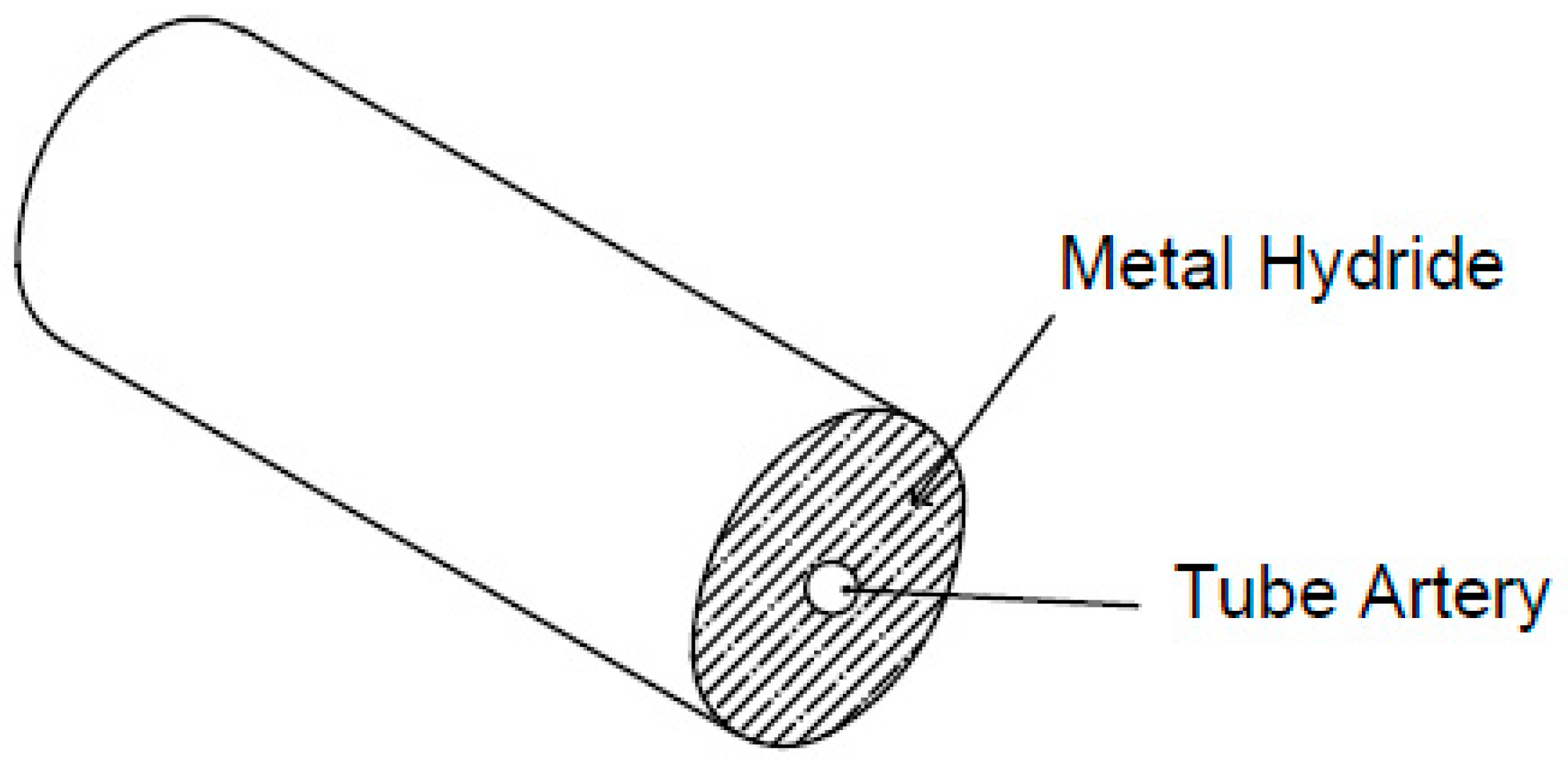
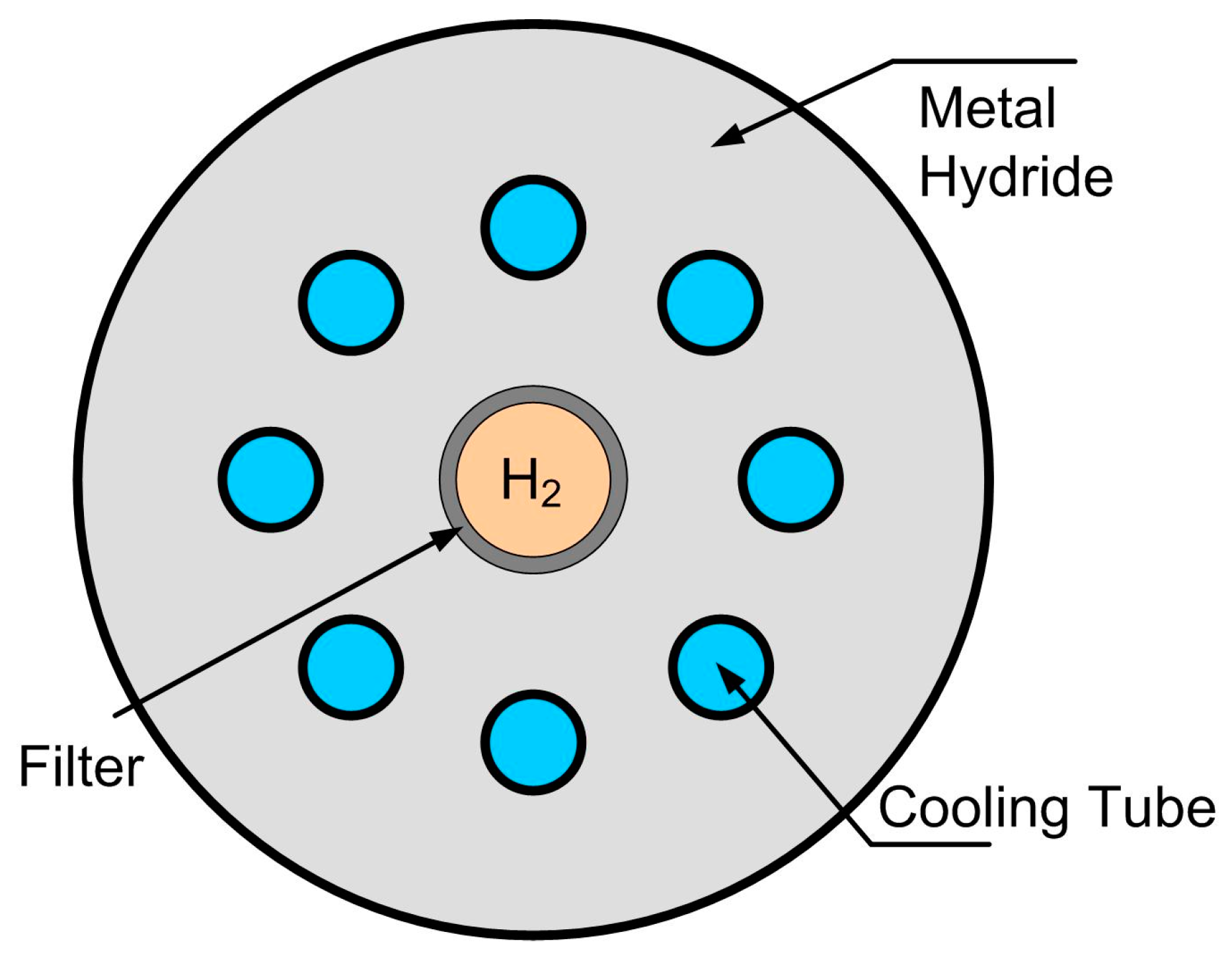
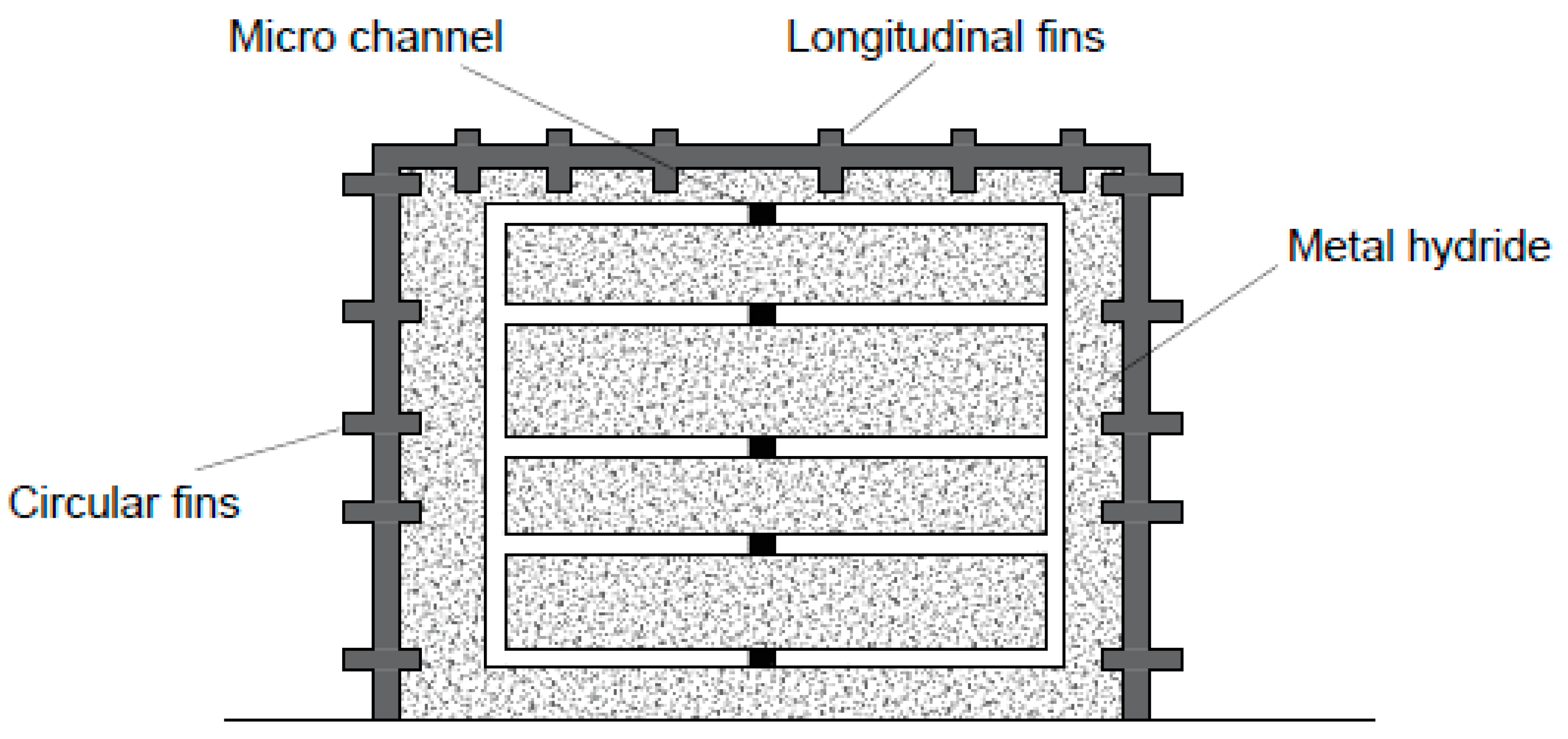
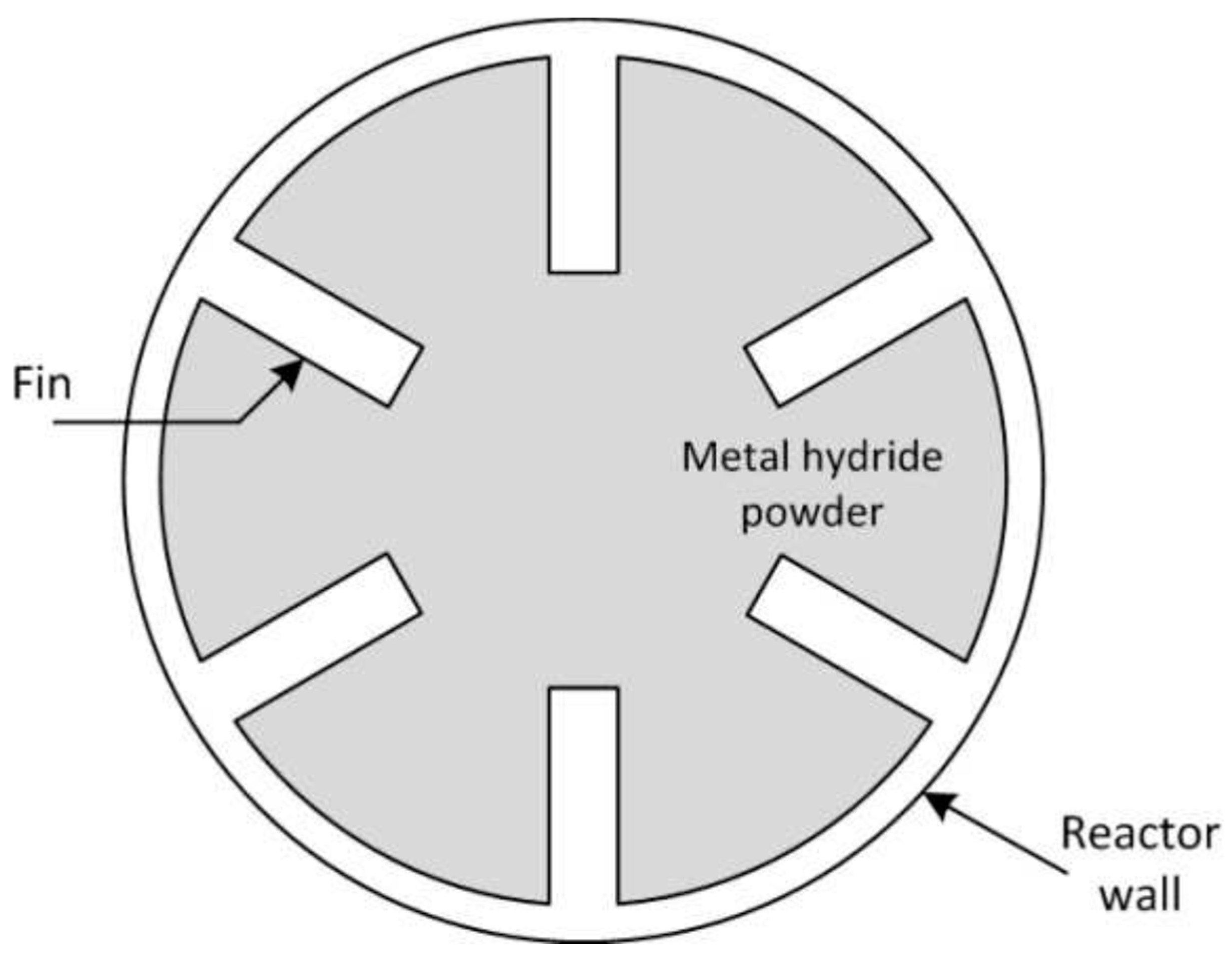
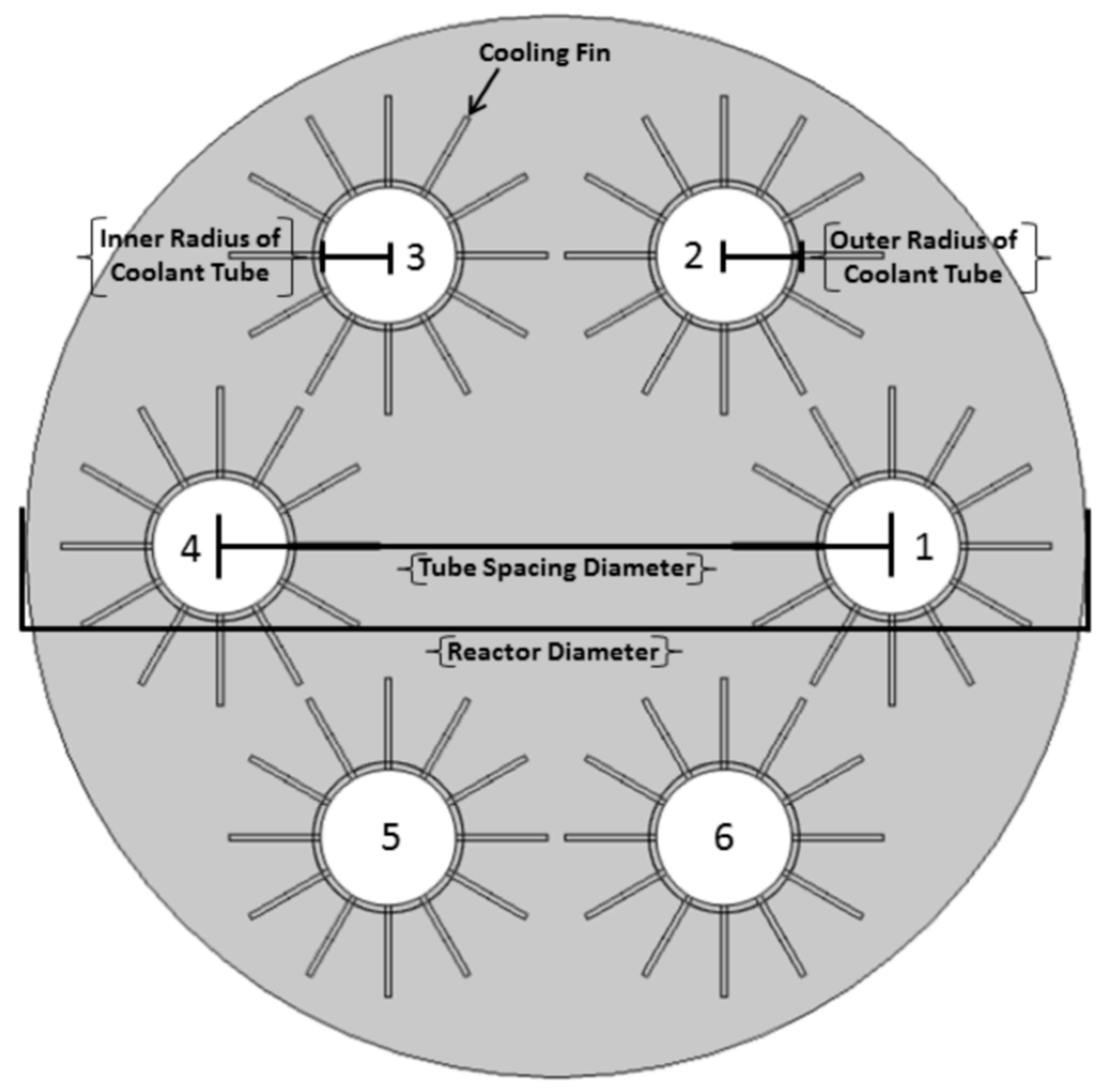
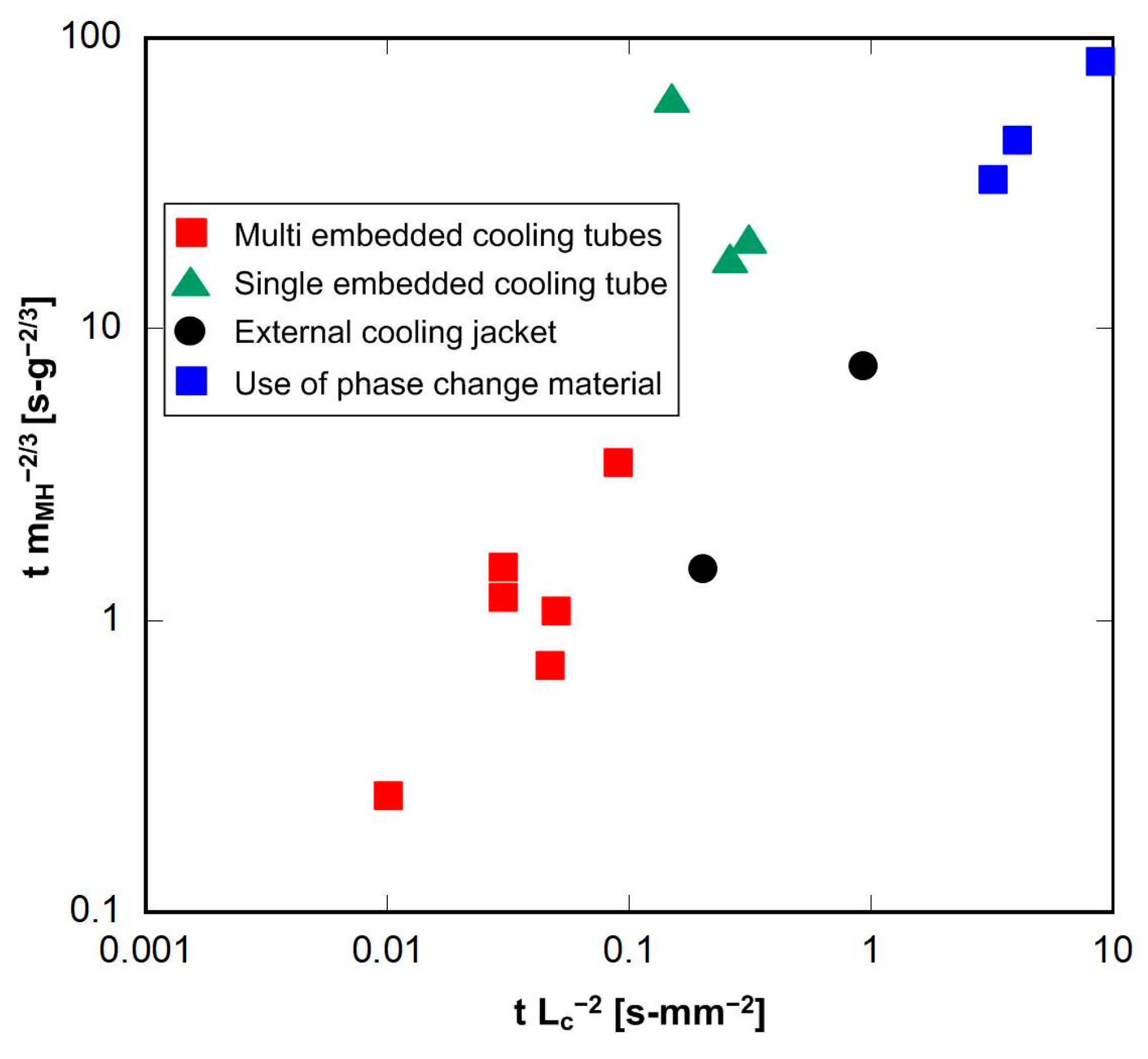

| References | Technology Area | Engineering System | Pros | Cons | Suggested Hydrides |
|---|---|---|---|---|---|
| [6]—Krane et al., 2022 | Energy Storage | Two-reactor metal hydride system |
|
| MgH2, TiFeH2, LaNi5H6 |
| [7]—Zhang et al., 2023 | Catalysis | Ammonia synthesis |
|
| Lanthanum hydride |
| [8]—Lv, Y. et al., 2023 | Energy storage | Magnesium hydride conversion electrode |
|
| Magnesium hydride |
| [9]—Zhou et al., 2023 | Fuel cells | Hydrogen feeding system |
|
| RE-based and Ti-based multicomponent metal hydrides |
| [10]—Tiwari and Sharma, 2023 | Energy storage | Metal hydride reactor and thermocline-based heat storage system |
|
| MgH2 |
| [11]—Alok Kumar, P. Muthukumar, 2022 | Hydrogen storage and purification |
|
| La0.9Ce0.1Ni5 | |
| [12]—Krishnamoorthy et al., 2023 | Battery modeling | Lithium–ion and nickel–metal hydride batteries |
| Nickel-metal hydride battery | |
| [13]—Zhang et al., 2022 | Chemicals | CO2 capture |
|
| Nickel hydride complexes |
| [14]—Brestovič, T. et al. 2022 | Metal Hydride Compressors | Heat pump-based compression system |
|
| LaNi5 |
| [15]—Massaro et al., 2023 | On-board hydrogen storage technologies | Fuel cell systems for aircraft electrification |
|
| |
| [16]—Nguyen and Shabani, 2022 | Metal hydride hydrogen storage | Standalone solar hydrogen systems |
|
| |
| [17]—Eadi et al., 2023 | Hydrogen gas sensing | Pd-Ni alloy thin films |
|
| |
| [18]—Kumar et al., 2022 | Metal hydride-based hydrogen storage | Standalone microgrids |
|
| MgH2, TiFeH2, LaNi4.8Al0.2H11.3 |
| [19]—Tian et al., 2022 | Hybrid rocket propulsion | Solid-fuel additives |
|
| |
| [20]—Lee et al., 2022 | Hydrogen storage | Magnesium hydrogen tank |
|
| MgH2 |
| [21]—Sezgin et al., 2022 | Hydrogen energy systems | Underwater applications |
|
| TiFe, LaNi5, AB2 (MmNi3.6Co0.7Mn0.4Al0.3), MgH2, LiBH4 |
| [22]—Kailiang Ren, Jiajia Miao, et al., 2022 | Electrochemical energy storage | Batteries |
|
| NiMH |
| [23]—Dinesh Dashbabu, E. Anil Kumar, I.P. Jain, 2022 | Hydrogen compression | Metal hydride hydrogen compressor |
|
| LaNi5H6-xAlx |
| [24]—Sayantan Jana et al., 2022 | Heating and cooling | Embedded cooling tube type metal hydride reactor |
|
| Mg2NiH4, Top of Form |
| bottom of form | |||||
| [25]—Singh et al., 2022 | Renewable energy | Reversible SOFC, hydrogen storage, rankine cycle, absorption refrigeration |
|
| LaNi4.8Al0.2, MgH2, Ni-MH alloy, CaH2 |
| [26]—H. Chang, Y.B. Tao, H. Ye, 2023 | Hydrogen and thermal storage | Sandwich reaction bed filled with metal hydride and thermochemical material |
|
|
| Reference | Thermal Management Technique | Observations |
|---|---|---|
| [77]—Rahul U. Urunkar, Sharad D. Patil (2021) | Use of various nanofluids for enhancing heat and mass transfer in metal hydride reactor for hydrogen storage |
|
| [78]—Syedvali Pinjari et al. (2023) | Acid functionalized carbon nanotubes |
|
| [79]—Atef Chibani et al. (2022) | Phase change material incorporated in porous media (metal foam) |
|
| [80]—Huy Quoc Nguyen et al. (2022) | Organic phase change material |
|
| [81]—Atef Chibani, Slimane Merouani, Noureddine Gherraf, Yacine Benguerba (2022) | Phase change material–metal foam-based latent heat storage system |
|
| [82]—Atef Chibani, Aissa Dehane, Slimane Merouani, Cherif Bougriou, Djemaa Guerraiche (2022) | Melting/solidification of phase change material in a multi-tube heat exchanger in the presence of metal foam |
|
| [83]—A. Chibani, S. Merouani, N. Gherraf, I. Ferhoune, Y. Benguerba (2022) | Phase change material with nano-oxide additives |
|
| [84]—Atef Chibani et al. (2022) | Metal hydride-phase change material reactor with nano oxide |
|
| [85]—Elarem, Raja, et al. (2021) | Nanoparticles enhanced phase change material and nanofluid |
|
| Metal Hydride Material | Thermal Conductivity (Wm−1K−1) |
|---|---|
| MgH2 | 4.3 |
| TiFeH2 | 4.6 |
| LaNi5H6 | 13.5 |
| FeTiH2 | 10.0 |
| CaNi5H6 | 10.0 |
| ZrCoH2 | 12.0 |
| Mg2NiH4 | 10.0 |
| FeTiH1.9 | 10.0 |
| Mg2FeH6 | 4.0 |
| PdH0.6 | 71.0 |
| TiCr0.5V0.5H2 | 8.0 |
| LiBH4 | 2.4 |
Disclaimer/Publisher’s Note: The statements, opinions and data contained in all publications are solely those of the individual author(s) and contributor(s) and not of MDPI and/or the editor(s). MDPI and/or the editor(s) disclaim responsibility for any injury to people or property resulting from any ideas, methods, instructions or products referred to in the content. |
© 2023 by the authors. Licensee MDPI, Basel, Switzerland. This article is an open access article distributed under the terms and conditions of the Creative Commons Attribution (CC BY) license (https://creativecommons.org/licenses/by/4.0/).
Share and Cite
Kukkapalli, V.K.; Kim, S.; Thomas, S.A. Thermal Management Techniques in Metal Hydrides for Hydrogen Storage Applications: A Review. Energies 2023, 16, 3444. https://doi.org/10.3390/en16083444
Kukkapalli VK, Kim S, Thomas SA. Thermal Management Techniques in Metal Hydrides for Hydrogen Storage Applications: A Review. Energies. 2023; 16(8):3444. https://doi.org/10.3390/en16083444
Chicago/Turabian StyleKukkapalli, Vamsi Krishna, Sunwoo Kim, and Seth A. Thomas. 2023. "Thermal Management Techniques in Metal Hydrides for Hydrogen Storage Applications: A Review" Energies 16, no. 8: 3444. https://doi.org/10.3390/en16083444
APA StyleKukkapalli, V. K., Kim, S., & Thomas, S. A. (2023). Thermal Management Techniques in Metal Hydrides for Hydrogen Storage Applications: A Review. Energies, 16(8), 3444. https://doi.org/10.3390/en16083444





